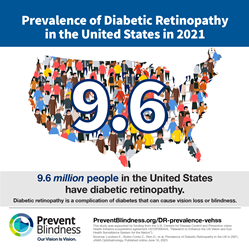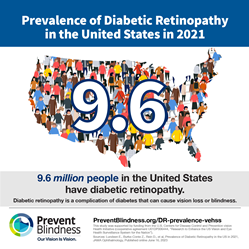
Data from new study, ‘Prevalence of Diabetic Retinopathy in the US in 2021’ study shows estimated 9.6 million people in the United States had eye disease diabetic retinopathy.
“The number of diabetes cases in America continues to grow, and with that, so are the damaging effects on vision. It is our hope that this new data will guide us to successful interventions and improved outcomes for those with diabetes and their families.”-Jeff Todd, Prevent Blindness.
CHICAGO (PRWEB)
June 16, 2023
A new study published today in JAMA Ophthalmology, “Prevalence of Diabetic Retinopathy in the US in 2021,” found that in 2021, an estimated 9.6 million people in the United States (26.4 percent of those with diabetes) had diabetic retinopathy (DR), and 1.84 million people (5.1 percent of those with diabetes) had vision-threatening diabetic retinopathy (VTDR). The number of people aged 40 years and older living with diabetes-related eye disease more than doubled since prevalence was last estimated in 2004. VTDR has also almost doubled since last estimated in 2004.
The study is the first of its kind to estimate the prevalence of DR and VTDR in people younger than 40 years. In the youngest age group, ages 0 to 24 years, more than 1 in 10 people with diabetes had DR, which increased to nearly 1 in 5 among people with diabetes ages 25 to 39 years.
Diabetic retinopathy occurs when small blood vessels leak and bleed in the retina. The retina is the layer of cells lining the back wall inside the eye that senses light and sends signals to the brain for vision. Early detection and treatment can reduce the risk of vision loss from this potentially blinding eye disease.
The ‘Prevalence of Diabetic Retinopathy in the US in 2021’ study was authored by researchers from the Centers for Disease Control and Prevention’s (CDC) Vision Health Initiative, NORC at the University of Chicago (NORC), and the Institute for Health Metrics and Evaluation (IHME) at the University of Washington (Seattle), with support from Prevent Blindness, the nation’s oldest eye health and safety nonprofit organization.
“The national increase of diabetes over the last two decades has likely impacted the number of people living with serious complications like diabetic retinopathy,” said CDC epidemiologist Elizabeth Lundeen, PhD, MPH. “This study provides new state and county level prevalence estimates that the health care and public health communities can use to inform screening and early interventions for optimal vision health.”
Abraham Flaxman, PhD, added: “In this work, we brought together data from all the relevant sources in the CDC’s Vision and Eye Health Surveillance System to triangulate between multiple measurements and make estimates that no single source could provide alone.”
Additional key findings from the study include:
-
Approximately 1 in 4 Americans ages 40 and older with diabetes have DR. - These new estimates include the prevalence of DR and VTDR in people younger than age 40 years. Past prevalence estimates were only for the US population aged 40 and older.
- VTDR prevalence rates are higher for Black (8.7 percent) and Hispanic (7.1 percent) individuals than White individuals (3.6 percent). Thus, a higher percentage of Black and Hispanic individuals with diabetes are at risk for vision loss compared to their White counterparts.
- The prevalence of both DR and VTDR varied widely by U.S. state and county. After standardizing by age, sex/gender, and race/ethnicity, rates of DR among persons with diabetes ranged from a low of 21.2 percent in Nevada to a high of 34.2 percent in Hawaii.
- Prevalence of DR and VTDR among people with diabetes increased substantially with age but then decreased in the older age groups, likely because DR and VTDR are markers for more severe diabetes, which can lead to early mortality.
“This study demonstrates the value of vision surveillance, which allows us to monitor emerging trends in vision threatening conditions like diabetic retinopathy,” said David B. Rein, Ph.D., Program Area Director for NORC at the University of Chicago’s Public Health Analytics Program and one of the study’s co-authors. “The information provided in this study can be used at the national, state, and county level to understand the burden of diabetic retinopathy and to design interventions to help people living with the condition preserve their vision.”
Study estimates were developed using data from CDC’s Vision and Eye Health Surveillance System (VEHSS). The VEHSS leverages new and existing data sources to help health professionals, researchers, policy makers, and patients understand the scope of vision loss, eye disorders, and eye care services in the United States. Detailed estimates of DR and VTDR at the national-, state-, and county-level stratified by age group, sex/gender, and race/ethnicity can be accessed online at the VEHSS website (https://www.cdc.gov/visionhealth/vehss/estimates/index.html).
Prevent Blindness serves as an education and communications partner for the VEHSS. For diabetes patients and their care partners, Prevent Blindness offers a wide variety of user-friendly resources in English and Spanish, including downloadable fact sheets, patient educational videos, and a listing of eye care financial assistance resources.
For healthcare professionals, community health educators, and diabetes educators, Prevent Blindness provides the newly redesigned Diabetes + The Eyes educational toolkit. This free program includes an educator course with PowerPoint presentations and scripts, fact sheets, and social media graphics.
“The number of diabetes cases in America continues to grow, and with that, so are the damaging effects on vision,” said Jeff Todd, president and CEO of Prevent Blindness. “It is our hope that this new data will guide us to successful interventions and improved outcomes for those with diabetes and their families.”
For more information on the “The Prevalence of Diabetic Retinopathy in the United States In 2021” study or the VEHSS, visit https://www.cdc.gov/visionhealth/vehss/. Or visit the Prevent Blindness page at https://PreventBlindness.org/DR-prevalence-vehss.
For information on diabetes-related eye diseases, please visit https://preventblindness.org/diabetes/.
About the Vision Health Initiative
CDC’s Vision Health Initiative (VHI) works to improve vision health in the U.S. through collaborations with state and national partners to strengthen science and develop interventions that promote eye health and prevent vision loss and blindness in groups at high risk. VHI also seeks to address risk factors like glaucoma, reduce disparities in vision loss and eye disease, and improve health and quality of life for people with vision loss. VHI designs and implements public health surveillance at the state and national level, supports applied public health research, and promotes the dissemination of evidence-based vision health interventions. In collaboration with state and community partners, VHI works to integrate vision health activities into broader public health strategies and interventions. For more information, visit http://www.cdc.gov/visionhealth.
About NORC at the University of Chicago
NORC at the University of Chicago conducts research and analysis that decision-makers trust. As a nonpartisan research organization and a pioneer in measuring and understanding the world, we have studied almost every aspect of the human experience and every major news event for more than eight decades. Today, we partner with government, corporate, and nonprofit clients around the world to provide the objectivity and expertise necessary to inform the critical decisions facing society.
http://www.norc.org
About the Institute for Health Metrics and Evaluation
The Institute for Health Metrics and Evaluation (IHME) is an independent global health research organization at the University of Washington School of Medicine that provides rigorous and comparable measurement of the world’s most important health problems and evaluates the strategies used to address them. IHME is committed to transparency and makes this information widely available so that policymakers have the evidence they need to make informed decisions on allocating resources to improve population health.
About Prevent Blindness
Founded in 1908, Prevent Blindness is the nation’s leading volunteer eye health and safety organization dedicated to fighting blindness and saving sight. Focused on promoting a continuum of vision care, Prevent Blindness touches the lives of millions of people each year through public and professional education, advocacy, certified vision screening and training, community and patient service programs and research. These services are made possible through the generous support of the American public. Together with a network of affiliates, Prevent Blindness is committed to eliminating preventable blindness in America. For more information, visit us at PreventBlindness.org, and follow us on Facebook, Twitter, Instagram, LinkedIn and YouTube.
###

